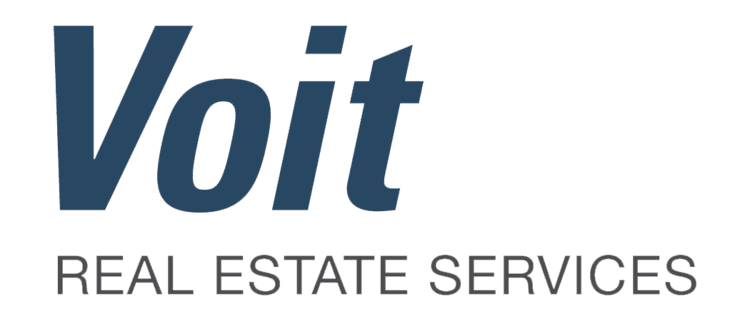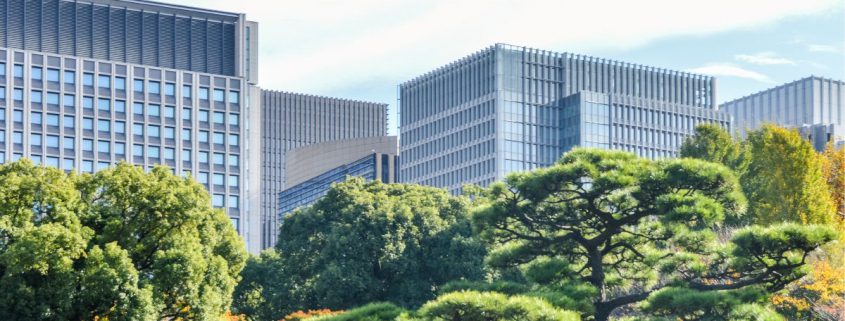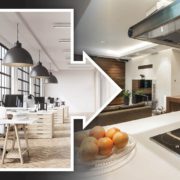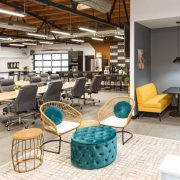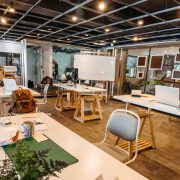Use Office Space to Promote Activity and Mental Wellbeing
How are you spending your time? And in what environment?
According to the Huffington Post, the average person spends over 13 years of their life at work. This considered, the environment you work in has a huge impact on your mental wellbeing.
But the good news? You can use office space to promote positive change in your activity and mental wellbeing. At Voit Real Estate Services, we’re here to share some best practices. First, let’s discuss a bit about the office we know today.
The Office Today
2020 brought upheaval to the workplace as we know it. Whether you were working remotely during the pandemic or not, in 2020, society learned very quickly about the great influence one’s work environment has on their activity levels and mental wellbeing.
Kitchens became zoom backgrounds, audio muted as a result of children who were learning from home… In the past two years, there has become a wide focus not only on mental health in the workplace but also on how workplace design can support an individual’s wellbeing.
Additionally, with life returning to some sense of normalcy over two years later and a large number of employees are working in person again, many companies are keeping their eye on office design and how it can benefit their employees’ productivity and mental health—and rightfully so.
Let’s discuss how your company can use office space to promote activity and mental wellbeing.
How Your Company Can Promote Activity and Mental Wellbeing Through Office Design
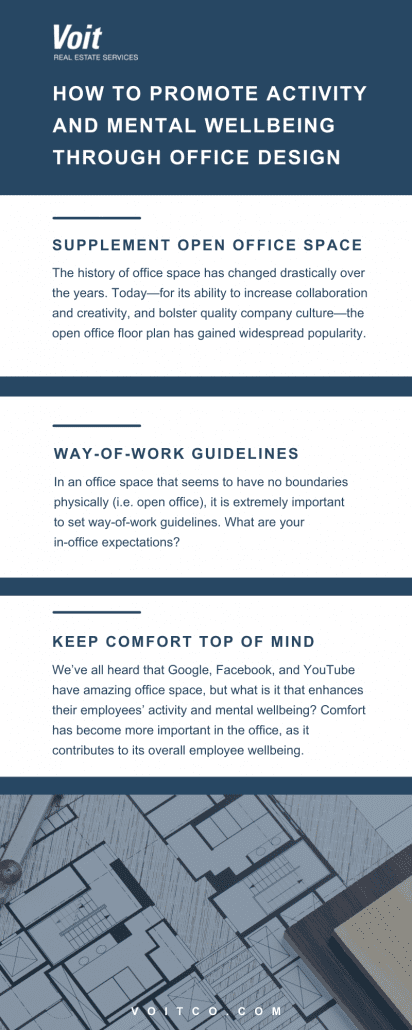
Various studies have shown that companies who prioritize their employees’ wellbeing and mental health, specifically through office design, have more productive and happy employees.
The University of Warwick completed a study in which they found a 12% productivity boost in happy employees who felt supported. As a result, these companies that emphasize office design have an easier time retaining their employees.
Here’s how you can achieve this as well.
Supplement Open Office Space
The history of office space has changed drastically over the years. Today—for its ability to increase collaboration and creativity, and bolster quality company culture—the open office floor plan has gained widespread popularity.
In other words, goodbye, cubicles! With every trend, however, comes a flaw.
The open office is essentially a big room filled with multiple desks and multiple employees—a recipe for distraction! Unwanted noise and a lack of privacy can contribute to unproductive, stressed employees.
The solution? When considering your office design, ensure that you offer your employees a variety of spaces in which to work. This looks different for every company:
- Conference rooms
- Quiet spaces
- Lounge areas
Additionally, a growing body of research has taught us about the human desire to work in a healthy environment. Many companies are even going as far as offering meditation rooms, incorporating natural elements like plants and natural light, and even sleeping pods in their office spaces.
An article by Forbes analyzed the Fellowes Workplace Wellness Trend Report, where they found that “93% of workers in the tech industry said they would stay longer at a company who would offer healthier workspace benefits, with options ranging from wellness rooms, company fitness benefits, sit-stand [desks], healthy lunch options, and ergonomic seating.”
The bottom line: The future of the office (especially with the majority of people now having experienced remote work!) is anticipated to be highly flexible—allowing employees to work how and where they want.
Establish Way-of-Work Guidelines
In an office space that seems to have no boundaries physically, it is extremely important to set way-of-work guidelines.
In other words, what are your in-office expectations?
Are there specific areas meant for socializing? Areas that are specifically meant for quiet, ‘head down’ type of work? What are your expectations for communicating with team members or managers? How can you reserve conference rooms or individual office space?
Additionally, considering COVID-19, what are your company policies to keep your employees safe? How will you enforce them?
Setting out clear way-of-work guidelines—and ensuring that your entire team is onboard—alleviates confusion and is crucial to creating a functional, efficient office space.
Keep Comfort Top-of-Mind
We’ve all heard that Google, Facebook, and YouTube have amazing office space, but what is it that enhances their employees’ activity and mental wellbeing?
If you look around at top companies today, their offices might resemble a home more than a workspace. Office design has shifted through the years and over time, comfort has become more important in the office, as it contributes to its overall employee wellbeing.
In an account of the history of office design, it is reaffirmed that today, the “modern workplace takes inspiration from the home.” This can be seen through the “use of warm colors, intimate lighting, and soft seating.”
In this article, they write that comfortable office design has become all the more important as a tool to “attract and retain the very best talent in a competitive marketplace.”
A great example of comfort within the workplace comes from Kaiser Permanente. They will soon champion their “Thrive Center”—their national headquarters in downtown Oakland where 7,000 employees will work. The Thrive Center will span nearly 1.7 million square feet with completion expected in 2023.
But more importantly? The Thrive Center’s design. According to an article from VatorNews, “the initial building renderings of the interior are focused largely on the idea of biophilic design, bringing natural elements inside, and the layout of the building is built to be more human and focused on this type of mental health awareness and positivity.”
VatorNews believes looking forward, “these types of initiatives will just keep improving as they become standard in the industry.”
And although many companies do not have the means to create a custom workplace from scratch, there are fundamental things that every company should consider in their office space to promote activity and mental wellbeing.
At the least, consider these seven elements from the WELL Building Standard:
- Air
- Water
- Nourishment
- Light
- Fitness
- Comfort
- Mind
Where does your office space stand in each of these elements, and how can you improve?
The Importance of Creating a Productive Work Environment
In the 1940s, American psychologist Abraham Maslow, who is credited with creating the “hierarchy of needs” theory, stated that business leaders can “set up the conditions so that peak experiences are more likely, or can perversely set up conditions so that they are less likely.”
At Voit, we recognize that the importance of one’s environment in regards to productivity, happiness levels, and mental wellbeing is only becoming more important.
Although we’ve long known the importance of creating a productive work environment, the stigma around mental health has been deeply rooted in our society and is just now seeming to fade away.
For this reason, we can anticipate that many companies will likely place a higher priority on how to use office space to promote activity and mental wellbeing in the future.
Although much has changed in the workplace since Maslow’s day, this fundamental value of one’s environment has stayed the same.
Interested in learning more? Read on to see how CRE is evolving to support hybrid workspaces or to find out the answer to the question “What Does the Future Hold for Commercial Office Space?”
